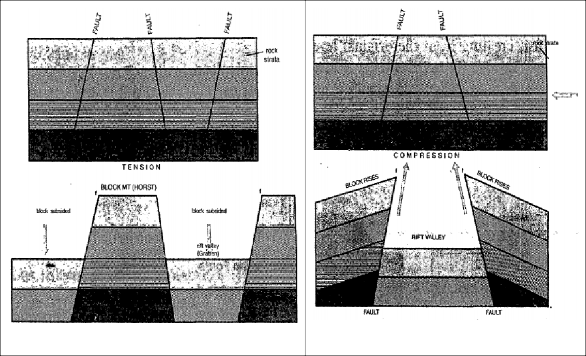1.1.2. Block Mountains
When the earth's crust bends, folding occurs, but when it cracks, faulting takes place. Faulting may be caused by tension or compression, forces which lengthen or shorten the earth's crust, causing a section of it to subside or to rise above the surrounding level.
Earth movements generate tensional forces that tend to pull the crust apart (fig. 4), and faults are developed. If the block enclosed by the faults remains as it is or rises, and the land on either side subsides, the upstanding block becomes the horst or block mountain. The faulted edges are very steep, with scarp slopes and the summit is almost level, e.g. the Hunsruck Mountains, the Vosges and Black Forest of the Rhineland.
Tension may also cause the central portion to be let down between two adjacent fault blocks forming a graben or rift valley, which will have steep walls. The East African Rift Valley system is 3,000 miles long, stretching from East Africa through the Red Sea to Syria.

Fig.5 Rift Valley formed by compressive forces
Fig. 4 Block Mountains formed by tensional forces
Compressional forces set up by earth movements may produce a thrust or reverse fault and shorten the crust. A block may be raised or lowered in relation to surrounding areas. Fig.5 illustrates a rift valley formed in this way. In general large-scale block mountains and rift valleys are due to tension rather than compression.
